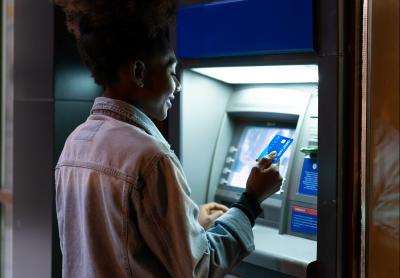Opportunities for waste management from solar and…

A point of view from Sia Partners' experts.


The idea of a cashless society is more than an evolutionary perspective of today's society. Rather than a futuristic scenario, it is the outcome of an evolutionary path that has already been going on for several years. The numbers are clear and demonstrate the progressive phase-out of cash. In some parts of the world, the use of cash is limited to levels below 10%: in 2022 in Sweden, for example, the weight of cash in total GDP was 8%. [1]
To get an idea of what a cashless society could look like, we can take a look at the evolution that some countries have had and have been undergoing for several years. If countries in Eastern Europe, Mediterranean Europe, Africa, and the Middle East, or even on the American continent, still show some resistance to switching away from the use of cash, there are other societies, typically more advanced from a digital point of view, such as Northern European countries, Canada, Brazil, or Australia and South Africa (to name a few), where cash is a rare commodity. [2]
The analysis of purchasing and payment habits prevalent in these latter countries offer valuable indications as to what are possible alternatives to banknotes and coins. Boosting the process of replacing cash with alternative payment methods globally, the post-pandemic economic recovery is proceeding at a faster pace than economic supply. The resulting imbalance creates fertile ground for the spread of new payment methods, more and more appreciated particularly by the younger generation. Digital Currency, Crypto, Blockchain, and e-wallets are increasingly popular, especially among the latest generation of consumers who find that their high security standards, low management costs, and ease of use make them preferable to cash.
While it is easy to imagine how consumer payment habits will change and evolve in a cashless society, from observing what is happening in such realities, the future for retailers is still unclear. They have mostly limited themselves to accepting new payment methods as there are still doubts about the future of certain businesses and services whose reason for existing is the presence of cash.
As far as Retailers are concerned, the growth of the e-commerce market in recent years is a form of evolution towards a cashless society. However, it must be emphasized that today's e-commerce has benefited from changing shopping habits but has not yet evolved significantly, remaining very similar to how it was born. This has not led to a real overtaking of brick-and-mortar stores, which continue to account for an important share of world trade and a slowing down in the farewell to cash. Even though almost all physical shops ensure the acceptance of multiple alternative payment instruments (card-based first and foremost), they are the places where cash continues to find strong usage.
As far as Financial Institutions are concerned, they must respond in a convincing manner to the evolution of Open Banking and, more generally, Open Finance, to limit the loss of revenues due to the gradual disappearance of cash-related services (e.g. cash transport, counting rooms) and to transform the current infrastructure (eg. the ATM network) into something that can guarantee an adoption by the consumers of tomorrow. It is no coincidence, for instance, that some important states (China above all, but also the US and several EU states in tow) have been working on the introduction of their own digital currency, and the surrounding ecosystem to support it.

The process of cash replacement, coupled with an exponential growth in the rate of digitization of services, and our daily habits, implies that payment instruments, i.e. the tools that enable us to pay, are evolving in ways that were unthinkable a few years ago. A world without payment cards a few years from now is likely.
In particular, the use of smartphones has exploded among millennials and the following generations. This has generated the rise of virtual wallets (real apps) through which traditional payment cards are tokenized within the same mobile device. This step constitutes the most important element in the payment card substitution process to date. Whether one uses a phone, a smartwatch, or any other wearable technology, the payment card, intended as a plastic or metal card on which a chip or magnetic band is installed, is no longer necessary.
In the wake of this phenomenon, other 'wearables' suitable for use in the execution of a payment have appeared today. Rings or bracelets are spreading quite rapidly among the latest generation of consumers.
A further step towards replacing traditional payment cards is the subcutaneous chip implants, e.g. in the palm of the hand, which enable de facto payments without having to wear any device. Very interesting is the Amazon initiative, which, in partnership with a large grocery chain, has introduced POSs capable of accepting payments by identifying a previously tokenized payment instrument by recognizing the palm of the consumer's hand.
All these use cases represent valuable alternatives to payment cards in the execution of payments, but they still depend on the traditional instrument, which must be associated in advance with the device/chip/palm of the hand.
The real disruptive innovation will occur when the banking network and payment institutions will cease distributing payment cards and initiate associating payment instruments with digital identities for their customers. The data carried by the payment card will be associated directly with biometrics: a person's fingerprints, the scan of their retina, a person's voice print, or a chip that will be implanted under the skin. Thanks to this evolution and the use of other technologies such as blockchain and digital money, a cardless and cashless society can be realized at the same time as a revolution in purchasing (as much as selling) and consumption habits.
A boost to this process will come also from a security aspect: cyberattacks and fraud are expected to increase in the digital landscape, but physical fraud will lower dramatically, so the total balance will be in favor of the new scenario. In addition, both regulations (i.e. PSD3) and technological standards are evolving to make these environment safer and trusted. The use of AI and GenAI will help in fraud prevention and detection, strengthening algorithms, and providing services for customers.

Both Banks and other Financial Institutions, as well as Public Administration, will have to equip themselves to replace the traditional issuing of current payment instruments, payment cards in the first place, with instruments capable of indisputably verifying the identity of end consumers based on human factors. They will also need to enable the execution of payments without physical devices, such as cash, payment cards or other devices external to the person. Biometrics (retina scanning, fingerprinting), implantation of subcutaneous chips for the execution of payments, augmented reality for eCommerce purchases, (creation of a uniquely identified avatar via blockchain) are examples of evolution in this direction.
Virtual shops installed inside mirrors (Magic Mirror) placed in hotel lobbies or in transit areas of stations and airports, in front of which one can see oneself wearing a hologram of an outfit before departure and then collect it at the destination airport. An evolution of today's concept of omnichannel is a high increase in transactions realized via Live Commerce, an evolution of the 1990s infomercials with influencers and salespeople as promoters, already widespread in China and other Asian countries, with payments via tokens linked to a User ID.
ATMs at which Credit granting practices can be completed with the support of virtual or remote managers who can intervene when needed or capable of accepting tax payments to the PA or other entities, realized with innovative non-card-based payment instruments (e.g. made through wearables or using voice).
Large retail brands, or large marketplaces, will send AR-visors to loyal customers through which they can present new collections or the latest news. Customers will be able to try on, choose and pay using their avatar without having to enter any payment card data. The visor will be able to verify the identity of the customer by scanning the retina, or by verifying the fingerprint or the sound of the voice.
Going one step further, the evolution of neural technologies may define further market scenarios far removed from the current one. We can imagine a society where there will be no more shops or e-commerce, instead, consumers will be able to identify products from the analysis of their own brain impulses. These technologies will be able to read the electrical impulses produced by the brain, give shape to the object one needs and search for it within several Metaverse and then propose it within a shortlist of products to the final consumer, who will be able to carry out this entire purchasing experience from the comfort of their own home. Once chosen, the product will be packaged by the manufacturer on duty and transported by drones directly to the customer's home. Each one will be associated with a virtual ID and a digital account that will be handled occasionally without requiring specific actions from the consumer.
Is this the future of payments? We should have more clarity over the coming years. But we think this could be a not-so distant future.
1. Rapporto 2023 – Cashless Society, Gruppo Ambrosetti.
2. Elaboration from TEHA on data from Central Banks, CIA World Factbook and World Bank 2023.